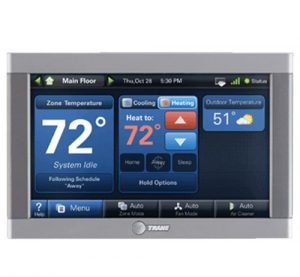There are few things more frustrating than dealing with a tripped circuit breaker—especially in the middle of a frigid winter night. You crank up the thermostat expecting that beautiful heat to flow, only to be met with dead air and darkness.
If your furnace is the culprit behind those breaker trips, it’s definitely cause for concern. From overloaded circuits to failing components, several issues could be triggering that shutoff safety mechanism.
Don’t panic just yet though! This guide will walk through some of the most common furnace tripwire causes, DIY troubleshooting steps you can try, and when it’s time to call in professional backup.

Confirming the Culprit
Before getting too far down the rabbit hole, let’s make sure we’re actually dealing with a furnace issue behind those pesky breaker trips. Pay attention for some pretty clear signs it’s your heating system causing the circuit overloads:
Signs That It’s Your Furnace Tripping the Breaker
- The circuit breaker trips immediately when the furnace kicks on or while it’s actively running. If the breaker holds steady until the furnace starts doing its thing, that’s a red flag.
- Resetting the tripped breaker leads to an almost instant re-trip once you try firing up the furnace again.
- You’ve ruled out other major appliances on that same circuit by unplugging them. If the breaker no longer trips with those disconnected, the furnace is the likely overload.
How to Isolate the Issue
While those signs make the furnace highly suspect, it’s still a good idea to take a few extra steps and positively isolate it as the root cause:
First, unplug or disconnect any other electrical devices or appliances sharing the furnace’s circuit that could potentially be adding to the load. Hair dryers, portable heaters, air purifiers – anything that draws significant amperage.
Next, check for any dedicated furnace circuits in your home’s electrical panel. Some systems require multiple 240V circuits, so you’ll want to identify and test each one independently to pinpoint the offender.
If the breaker automatically trips even when the furnace is the only thing running on a given circuit, you’ve got your confirmation. But if it holds steady with everything else disconnected, you may actually have an issue with another appliance or electrical fault causing those breaker trips.
Either way, narrowing it down to the furnace circuit puts you one step closer to diagnosing the root issue. From there, it’s time to take a look at some of the most common furnace-related reasons for those breaker overloads.
Common Furnace-Related Causes for Breaker Trips
There are actually several different potential reasons why your furnace may be the one tripping your circuit breakers over and over. From excessive electrical draws to internal component failures, it’s important to understand the most common culprits.
Identifying the root cause is key to getting your heating system operating safely and reliably again. Let’s go over some of the primary furnace issues that tend to overload circuits and explain why they trigger those breaker trips.
High Initial Current Draw
Many furnaces, especially older models, tend to draw an extremely high amount of electrical current when first firing up after a period of inactivity. This intense initial amp load can easily overload and trip circuit breakers not rated for that short-term surge. While it may only last a few seconds, that burst puts significant strain on your electrical system.
Overloaded Circuit
As mentioned earlier, if your furnace shares its circuit with multiple other appliances and devices, you run the risk of the total combined electrical load exceeding that breaker’s rated amperage. This becomes especially problematic with older homes that don’t have dedicated HVAC circuits installed per modern code requirements. An overloaded circuit will inevitably lead to breaker trips.
Short Circuit in Furnace Wiring
Any kind of short circuit condition within the furnace’s internal wiring network essentially creates an easy path for electrical current to rapidly spike out of control. This intense amperage overload forces the circuit breaker to trip as a safety mechanism before that short can potentially start an electrical fire. Damaged or frayed wiring insulation often causes shorts.
Ground Fault
Similar to shorts, ground faults create an abnormal path for electrical current within the system, leading to hazardous conditions that cause breaker trips. This usually stems from wiring issues like deteriorated insulation allowing current to ground out improperly. Rapidly fluctuating amp loads tend to overload breakers before eventual burnouts or fire risks develop.
Faulty Components
Many of a furnace’s electrical components like the blower motor, transformer, or igniter draw significant amounts of amperage, especially as they age. When those components start to mechanically bind up or electrically short out internally, it places an excessive load on the circuit until the breaker inevitably gives way as a protective measure.
Improper Installation
If the furnace wasn’t installed correctly with properly rated circuit breakers and gauge wiring, you’ll inevitably run into tripped breakers. Oversized breakers can allow dangerous overdrawing, while undersized ones can’t handle even normal electrical loads. Having your system inspected by certified HVAC professionals is crucial to avoid these installation pitfalls.
Dirty or Clogged Filters
While it may seem unrelated, excessively dirty or clogged air filters create restricted airflow that forces furnace components like the blower motor to work much harder. This increased strain leads to higher amperage draws that can potentially overload circuits never intended for that level of electrical consumption over time.
Aging Wiring
As electrical wiring ages, insulation can become dried out and brittle, or sustained damage accumulates, leading to short circuits or grounding issues. Older aluminum wiring has additional problems with increased resistance that causes more heat buildup. These factors place greater loads on aging circuits until their breakers inevitably throw due to being overwhelmed.
As you can see, furnaces and circuit breakers have a delicate push-pull relationship when it comes to managing electrical loads properly. From high-current components and wiring issues to airflow blockages and simple circuit overloads – there are numerous ways that heating systems can disrupt electrical circuits to the point of causing breaker trips.
Understanding these common underlying causes at least provides a helpful starting point for troubleshooting. With some basic safety steps and strategic repairs or upgrades, it’s very possible to restore balanced operation between your furnace and electrical panel.
DIY Fixes
While professional HVAC service is highly recommended for many electrical issues, there are some DIY fixes and troubleshooting steps you can take to potentially resolve minor furnace breaker trips. However, it’s crucial to prioritize safety and avoid any work beyond your personal skill level to mitigate risks of injury, further damage, or code violations.
Start with the Basics
Before attempting any hands-on repairs, begin with resetting the tripped breaker and/or turning the furnace power switch off and back on to clear any minor overload conditions. Often a momentary electrical spike or circuit overheating is alleviated by cutting power temporarily.
Check Air Filters
Extremely dirty or clogged air filters force HVAC components like blower motors to work harder, increasing electrical loads. Replace or properly clean furnace filters if airflow appears obstructed.
Inspect Accessible Wiring
With the furnace unplugged or shut off at the service switch, you can visually inspect any accessible wiring connections and cables for signs of damage, fraying, or deterioration that may cause short circuits. However, avoid touching or disturbing electrical wiring.
Clear the Furnace Area
Remove combustibles or clutter surrounding the furnace and ensure there’s adequate clearance on all sides for proper airflow and access. Obstructions and poor ventilation can increase electrical loads.
Unless you’re highly experienced with electrical and furnace systems, it’s best to avoid more invasive DIY repairs like:
- Replacing faulty electrical components
- Adjusting furnace wiring connections
- Upgrading circuit breakers or panel work
- Adding dedicated furnace circuits
These tasks pose significant safety risks if performed improperly and often require code adherence. Leaving major repairs to certified HVAC professionals is strongly recommended.
Safety First
Always prioritize safety when attempting furnace DIY work. Power off systems fully, never bypass safety switches, use appropriate PPE, and have working fire extinguishers on hand. If you encounter any uncertainty, your safest option is to request professional service before potential hazards develop further.
When to Call a Professional
Sometimes even your best DIY troubleshooting efforts won’t be enough to solve those pesky furnace breaker trips. Knowing when to wave the white flag and call in the pros is just as important as trying to fix it yourself in the first place. You don’t want to create an unsafe situation or cause more damage through trial and error.
Persistent Breaker Trips
If you’ve tried the basic steps like resetting breakers, checking filters, and clearing the area but that circuit just keeps tripping shortly after the furnace kicks on – it’s probably time to get some expert eyes on the issue. Persistent breaker failures despite your best efforts point to an underlying electrical or mechanical issue that needs proper diagnosis.
Visible Damage
Any visible signs of damage to the furnace’s wiring should also be an immediate prompt to make that service call. We’re talking exposed conductors, scorched or melted insulation, or cables that just look sketchy. Faulty wiring creates huge safety hazards when it comes to potential short circuits or fire risks down the road. Best to leave anything electrical to licensed professionals.
Component Replacement
The same goes for situations where you suspect a major furnace component like the blower motor, hot surface igniter, or control board needs replacement. While you might be tempted to try swapping out that part yourself, there’s an art to properly sizing, wiring, and integrating replacements that requires training and expertise. You don’t want to void warranties or create other issues through improper installation.
Aging Equipment
If your furnace itself is just plain old and outdated – like 15 years or more of hard service under its belt – you may simply have an obsolescence issue on your hands. Aging equipment inevitably brings about electrical baggage in the form of deteriorating safety components, wiring insulation breakdowns, and the like. At that point, it’s often more cost-effective to look at replacement rather than wrestling with repeated repair bandaids.
Emergency Situations
And of course, any situations involving burning smells or visible smoke should prompt an immediate shutdown of the system and emergency call for professional service. Electrical fires are no joke, so it’s better to be safe than sorry if you notice those warning signs.
Safety First
Speaking of safety, that should ultimately be the guiding principle here. If you’ve reached a point in troubleshooting your furnace where you feel uncomfortable, out of your depths, or just plain uncertain of what to do next – walk away and get the experts involved. There’s never any shame in knowing your limits, especially when it comes to complicated electrical systems and equipment that could easily become hazardous with the wrong moves.
At the end of the day, while a little DIY know-how is always empowering, your health and home’s safety should take priority over potential repair savings. Most reputable HVAC companies offer affordable service plans and emergency response to quickly get things resolved properly. When it comes to something as critical as your furnace, it’s always better to be safe than sorry.
Don’t Let Furnace Breaker Trips Leave You Out in the Cold
There’s nothing quite like feeling that winter chill start to creep in when the furnace suddenly stops working. You check the thermostat, giving it a fidgety adjustment or two, hoping to kick that trusty heating system back into gear. But alas, those circuit breakers keep stubbornly tripping instead of warm air flowing.
Before you resign yourself to a frosty household, know that identifying and resolving common furnace issues behind breaker trips is absolutely doable. Whether it’s an overloaded circuit, aging components drawing excessive current, or simply a system that’s started showing its age, there are troubleshooting steps you can take.
For the do-it-yourselfers out there, start with the easy wins – swapping air filters, checking for airflow obstructions, or giving breakers a manual reset. Oftentimes simple maintenance addresses temporary overload situations. But don’t go getting overzealous with anything electrical or wiring-related beyond your skill level. Safety has to be the top priority.
If those basic steps don’t get your furnace playing nice with that breaker again, or you ever feel in over your head, know when to call in the professionals at BelRed Energy Solutions. As the Seattle-Everett area’s go-to home services experts since way back in 1986, we’ve pretty much seen it all when it comes to heating systems and electrical gremlins.
Our certified technicians excel at quickly diagnosing root causes and developing innovative solutions to restore steady, reliable heat distribution. We also prioritize open communication and education so you understand all options. At BelRed, your family’s comfort and peace of mind are what truly matter.
Don’t let tripped breakers or a misbehaving furnace leave you out in the cold any longer than necessary. Give our team a call at (855) 345-6161 and let’s get that heating system running like a dream again! Reliable warmth and exceptional service – it’s what BelRed has delivered for over 35 years.







